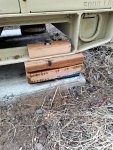- 588
- 1,379
- 93
- Location
- Wapakoneta, Ohio
Steel Soldiers now has a few new forums, read more about it at: New Munitions Forums!

Thanks! Only have a little time everyday to work on this thing. Appreciate your and everyone else's replies.The T bar is the handle, just tighten it all the way up (standard RH threads) and you should have no leaks when you fill the radiator.
Yes!Maybe you need to look at the TM's before deciding to weld up holes?
I tried bolting mine down and the vibration of the generator was amplified by the slab and vibrating the whole house. Of course my slab was not very thick and only a little bigger than the footprint of the 802.I'm building a concrete slab where the generator will sit. Do you guys bolt yours down to the concrete? How thick should I make the concrete slab?

I tried bolting mine down and the vibration of the generator was amplified by the slab and vibrating the whole house. Of course my slab was not very thick and only a little bigger than the footprint of the 802.
So I moved the generator forward a few inches and used the j-bolts in the concrete as pins, fitting into a hole in the wooden block. That keeps it from creeping around. The skid is lag-bolted to the blocks.
The blocks are sitting on air compressor isolators. This is working to keep it quiet and keep it from vibrating the house. I will eventually swap out the 2x6s for solid blocks as I think that will do a better job.
Definitely don't want to bolt it down tight, you need some kind of vibration isolation in there.
Those rubber isolation blocks Mainsail used are pretty cheap and available at plumbing supply houses or https://www.supplyhouse.com/Diversi...on-Pad-4-x-4-x-7-8?_br_psugg_q=vibration+pads
They are rated for 50 Psi.
Note that Mainsail's bolts are not going straight through the skid frame and into the concrete, that is a very important detail.
I'd use something like that or squares of 3/4" rubber horse stall mat both above and below the skid frame and I'd use threaded rod ( bent into a "J" ) in the concrete or bolts with the head and a washer buried in the concrete, then use a fender washer or a plate ( above the top rubber isolator ) and double jam nuts on top to snug it down slightly but not cranked down tight.
You want the rubber to be able to absorb the vibration without transmitting it through the bolt or tightly compressed rubber.
Looks like it will be a nice pad i usually throw plastic down if i dont have stone to go over the dirt, but wet the dirt down well before the pour and it should be fine. Glad someone has dry weather. another several inches here in ohio cant do anything.Here is the frame. All ready for concrete.
I appreciate all of this feedback. Thank you for the replies and tips!Shouldn't have the remesh wire touching the form, it should be fully encapsulated in the concrete, 2" min away from the form, but.. this is a generator pad, not the Washington Bridge....( not sure how many of you are aware of the problem with the bridge on 195 in RI ) so it will be fine.

